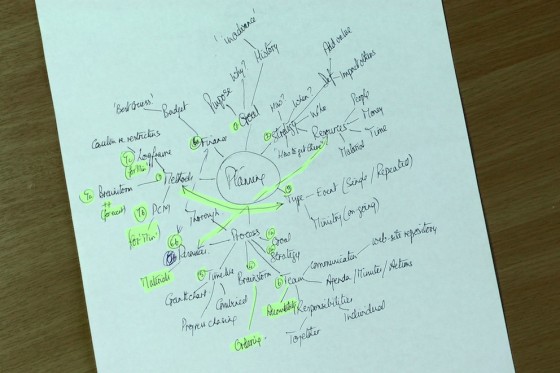 The illustration I used in the last brainstorm related to this series of blogs about Planning. However, since this does not illustrate planning an event I will first show you how to ‘clean up’ this brainstorm and then revert to a different example to show the importance of a timeline for event planning.
The illustration I used in the last brainstorm related to this series of blogs about Planning. However, since this does not illustrate planning an event I will first show you how to ‘clean up’ this brainstorm and then revert to a different example to show the importance of a timeline for event planning.
Ordering the results of a brainstorm
There are two stages to this.
1. Review each item in turn and amend the diagram.
Without the self imposed pressure of time, which initially I find valuable to help ideas to flow, you now review the diagram taking each item in turn and adding as appropriate. The result looks more cluttered as there are additions that have been made, as highlighted, but simplification will come in the next stage.

There are various activities I carry out during this stage:
a) Add further thoughts or detail that fills out the initial diagram
b) Delete any ideas that are not going to be pursued.
c) Link things in different ‘legs’ that need to be considered together.
d) Number the key features ready for transferring onto a sequential list
2. Tabulating
I now want to create an order in which I shall handle the various elements of this series. This can best be carried out on a table. A simplified version might look like this:
| Primary activity |
Detail |
| 1. Vision and Goals | Writing history in advance Purpose |
| 2. Strategy ‘How to get there’ | What will add value |
| 3. Brainstorming | Gathering ideas Ordering ideas |
| 4. Timeline | Scheduling |
| 5. Team building | Responsibilities Accountability Meeting dynamics |
| 6. Resources | Finance Materials |
| 7. Planning methods | PCM Logframe |
Much more detail would typically be included with perhaps further columns for sub-activities. But this illustrates how to take a random collection of ideas and put them in a format which can be handled in a logical order.
Next time we will look at creating Timelines pertinent to event planning
